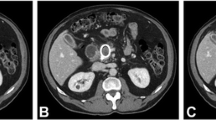Abstract
Background
Positron emission tomography (PET) as an adjunct to conventional imaging in the staging of pancreatic adenocarcinoma is controversial. Herein, we assess the utility of PET in identifying metastatic disease and evaluate the prognostic potential of standard uptake value (SUV).
Methods
Imaging and follow-up data for patients diagnosed with pancreatic adenocarcinoma were reviewed retrospectively. Resectability was assessed based on established criteria, and sensitivity, specificity, and accuracy of PET were compared to those of conventional imaging modalities.
Results
For 123 patients evaluated 2005–2011, PET and CT/MRI were concordant in 108 (88 %) cases; however, PET identified occult metastatic lesions in seven (5.6 %). False-positive PETs delayed surgery for three (8.3 %) patients. In a cohort free of metastatic disease in 78.9 % of cases, the sensitivity and specificity of PET for metastases were 89.3 and 85.1 %, respectively, compared with 62.5 and 93.5 % for CT and 61.5 and 100.0 % for MRI. Positive predictive value and negative predictive value of PET were 64.1 and 96.4 %, respectively, compared with 75.0 and 88.9 % for CT and 100.0 and 91.9 % for MRI. Average difference in maximum SUV of resectable and unresectable lesions was not statistically significant (5.65 vs. 6.5, p = 0.224) nor was maximum SUV a statistically significant predictor of survival (p = 0.18).
Conclusion
PET is more sensitive in identifying metastatic lesions than CT or MRI; however, it has a lower specificity, lower positive predictive value, and in some cases, can delay definitive surgical management. Therefore, PET has limited utility as an adjunctive modality in staging of pancreatic adenocarcinoma.
Similar content being viewed by others
References
Siegel, R., et al. (2011). “Cancer statistics, 2011: the impact of eliminating socioeconomic and racial disparities on premature cancer deaths.” CA Cancer J Clin 2011 61(4): 212–236.
O’Malley ME, et al. (1999) “Adenocarcinoma of the head of the pancreas: Determination of surgical unresectability with thin-section pancreatic-phase helical CT.” AJR 1999; 173: 1513–1518.
McCarthy MJ, et al. (1998) “Prediction of resectability of pancreatic malignancy by computed tomography.” Br J Surg 1998; 85: 320–325.
Miura F, et al. (2006) “Diagnosis of pancreatic cancer” HPB, 2006; 8: 337_342
Vellet AD, et al. (1992) “Adenocarcinoma of the pancreatic ducts: comparative evaluation with CT and MR imaging at 1.5 T.” Radiology 1992;/183:/87_95.
Stollfuss JC, et al. (1995) “2-(fluorine-18)-fluoro-2-deoxy- D -glucose PET in detection of pancreatic cancer: Value of quantitative image interpretation.” Radiology 1995; 195: 339–344.
Tempero, A et al. (2012) “Pancreatic Adenocarcinoma, Version 2.2012: Featured Update to NCCN Guidelines” J Natl Compr Canc Netw 2012;10:703-713
Seo, S., et al. (2008). “Contribution of 18F-fluorodeoxyglucose positron emission tomography to the diagnosis of early pancreatic carcinoma.” J Hepatobiliary Pancreat Surg 15(6): 634–639.
Imdahl, A., et al. (1999). “Evaluation of positron emission tomography with 2-[18F]fluoro-2-deoxy-D-glucose for the differentiation of chronic pancreatitis and pancreatic cancer.” Br J Surg 86(2): 194–199.
Kidd, E. A., et al. (2007). “The standardized uptake value for F-18 fluorodeoxyglucose is a sensitive predictive biomarker for cervical cancer treatment response and survival.” Cancer 110(8): 1738–1744.
Imsande, H. M., et al. (2011). “Use of 18F-FDG PET/CT as a predictive biomarker of outcome in patients with head-and-neck non-squamous cell carcinoma.” AJR Am J Roentgenol 197(4): 976–980.
Lyshchik A, et al. “Dual-phase 18F-fluoro-2-deoxy-D-glucose positron emission tomography as a prognostic parameter in patients with pancreatic cancer.” Eur J Nucl Med Mol Imaging 2005;32:389–397.
Wakabayashi H, et al. (2008) Role of 18F-fluorodeoxyglucose positron emission tomography imaging in surgery for pancreatic cancer.” World J Gastroenterol 2008;14:64–69
Disclosures
This work was selected as a Poster of Distinction at the 54th Annual Meeting of the Society for Surgery of the Alimentary Tract (SSAT) and as a Long Oral Presentation at the 47th Annual Meeting of the Pancreas Club both held in May 2013.
Author information
Authors and Affiliations
Corresponding author
Rights and permissions
About this article
Cite this article
Einersen, P., Epelboym, I., Winner, M.D. et al. Positron Emission Tomography (PET) has Limited Utility in the Staging of Pancreatic Adenocarcinoma. J Gastrointest Surg 18, 1441–1444 (2014). https://doi.org/10.1007/s11605-014-2529-x
Received:
Accepted:
Published:
Issue Date:
DOI: https://doi.org/10.1007/s11605-014-2529-x




